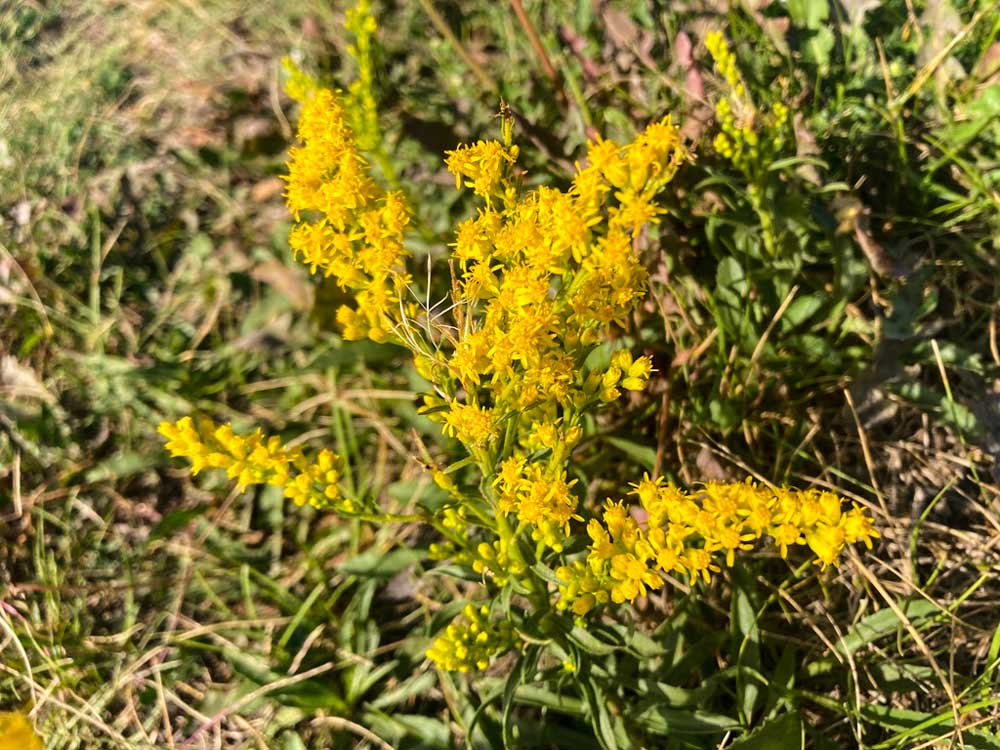Solidago missouriensis, commonly known as Missouri goldenrod, is a perennial herbaceous plant native to North America. It is a member of the Asteraceae family and is recognized for its bright yellow flowers that bloom from July to October, making it one of the earliest and longest-blooming goldenrods to flower each season.

Gardening Uses and Benefits
Missouri goldenrod is a versatile plant that thrives in dry to average soils and requires full sun to partial shade. It is easy to grow and can spread by rhizomes and seeds, making it suitable for naturalizing in prairies and open areas. Gardeners can use it for cut flower arrangements and as a pollinator attractor, particularly for native bees and butterflies. Additionally, it can be used for soil stabilization and revegetation of disturbed areas, such as mine spoils.

Companion Planting
Solidago missouriensis pairs well with several companion plants that complement its growth habits and enhance garden biodiversity. Here are some of the best companion plants:
New England Aster (Symphyotrichum novae-angliae): This plant blooms concurrently with goldenrod, creating a striking visual contrast with its purple flowers against the golden yellow of the goldenrod.
Blanket Flower (Gaillardia spp.): Known for its vibrant, daisy-like flowers, blanket flower blooms throughout the summer and into fall, providing continuous color alongside Missouri goldenrod.
Sticky Geranium (Geranium viscosissimum): This plant offers pink to purple blooms and can thrive in similar dry, sunny conditions, making it a suitable companion for Missouri goldenrod.
Pussytoes (Antennaria spp.): With its low-growing habit and silvery foliage, pussytoes provide a nice textural contrast and ground cover, complementing the upright form of goldenrod.
White Prairie Aster (Symphyotrichum ericoides): This aster blooms in late summer to fall, overlapping with goldenrod’s flowering period, and attracts a variety of pollinators.

Interesting Facts
- Missouri goldenrod is the state flower of Nebraska.
- It is listed as threatened in Michigan due to habitat loss.
- The plant has ethnobotanical uses; Native Americans historically chewed its leaves and flowers to relieve sore throats and toothaches.
Specialist Relationships with Invertebrates and Other Animals
Missouri goldenrod is considered a keystone native plant species and has significant ecological relationships with various invertebrates. At least 71 caterpillar species use it as a host plant, and 56 pollen specialist bees rely on it. It is particularly valuable to native bees, such as Bombus vagans (the half-black bumblebee), which are attracted to its flowers for nectar and pollen. The plant also supports conservation biological control by attracting predatory and parasitoid insects that help manage pest populations. Grasshoppers and other insects are drawn to its foliage, while small mammals and birds may visit the plant for its seeds and nectar.
Missouri goldenrod (Solidago missouriensis) attracts a variety of native bees, which are crucial for pollination. Some of the native bees known to visit Missouri goldenrod include:
- Andrena hirticincta
- Andrena nubecula
- Andrena placata
- Andrena simplex
- Andrena solidaginis
- Colletes simulans armatus
- Melissoides druriella
These bees are particularly important as they are oligolectic, meaning they specialize in collecting pollen from a limited group of plants, such as goldenrods and asters. This specialization helps ensure effective pollination of these plants, contributing to their reproductive success and maintaining biodiversity in the ecosystem.
Ecosystem Contributions
Missouri goldenrod plays a crucial role in supporting biodiversity. Its flowers provide a vital source of nectar and pollen for pollinators during late summer and fall, a critical time when other floral resources are scarce. The plant’s ability to form colonies helps stabilize soil and prevent erosion, contributing to the health of prairie ecosystems. Moreover, its presence in a garden can enhance the habitat for various wildlife species, promoting a more balanced and resilient ecosystem.
Missouri goldenrod is a valuable addition to any biodiversity-friendly garden. Its vibrant flowers, ease of growth, and ecological benefits make it an excellent choice for gardeners looking to support native wildlife and promote a healthy environment.
